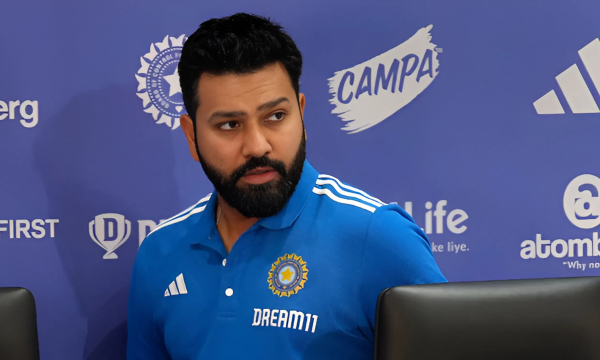
News Update
Tezzbuzz|05-02-2025
In the bustling city of Nagpur, under the glare of the evening sun, the Vidarbha Cricket Stadium was abuzz with anticipation.
On February 5, 2025, the Indian cricket team was gearing up for what would be their last significant preparation before the Champions Trophy.
It was at this pre-match press conference before the first ODI against England that Rohit Sharma, fondly known as ‘The Hitman’, made headlines for reasons beyond his usual prowess with the bat.
Rohit, stepping back into international cricket after a hiatus since the Melbourne Test, had faced some tough times in the Border-Gavaskar Trophy 2024/25.
His performance had not been up to his usual standards, leading to speculation about his future in the sport.
Media reports, swirling around like vultures, suggested that post the Champions Trophy, Rohit might be required to outline a transition plan.
This was a narrative that had been building for years, and at this press conference, it reached a boiling point.
The interaction began innocuously enough, with questions about strategy and team selections for the upcoming matches.
However, the atmosphere shifted when a journalist broached the subject of Rohit’s future post-Champions Trophy.
The question was direct, probing, and perhaps a tad insensitive given the context of his recent performances and the looming tournament.
Rohit Sharma Snaps At Reporter
“How is it relevant that I talk about my future plans when there are three ODIs and a Champions Trophy?” Rohit retorted, his voice a mix of irritation and disbelief.
His response was not just a deflection but a pointed critique of the media’s obsession with his career trajectory at a time when his focus should be, and was, on the immediate challenges.
“The reports (on my future) have been going on for a number of years, and I am not here to clarify those reports,” he continued, his tone firm, leaving no room for further discussion on the matter.
It was clear that for Rohit, the here and now, the upcoming matches against England, and the Champions Trophy were paramount.
“For me, the three games (against England) and the Champions Trophy are very important. My focus is on these games, and I will see what happens thereafter,” he concluded, signaling a shift back to the cricket at hand.
This moment of frustration from Rohit was not just about a single question but encapsulated a broader sentiment among athletes about the relentless scrutiny of their careers.
It’s a pressure cooker environment where every performance is dissected, every decision analyzed, and every future move speculated upon, often overshadowing the love for the game itself.
Rohit Sharma, at 37, is no stranger to such scrutiny. Alongside Virat Kohli, he is returning to the ODI format for the first time since India’s tour of Sri Lanka last year.
Their presence in the squad is not just about bolstering the team’s batting; it’s about leadership, experience, and the invaluable mentorship they provide to the younger brigade.
The series against England comes on the heels of a successful T20I series where India managed a convincing 4-1 victory, showcasing their dominance and adaptability in the shorter format.
Yet, ODIs, with their unique demands, present a different challenge, one where Rohit’s strategic acumen and batting flair could once again shine through.
As the press conference wrapped up, the focus returned to the cricket.
The upcoming matches were not just about winning; they were about setting the tone for the Champions Trophy.
For Rohit, these games were a testament to his resilience, his ability to block out the noise and focus on the love of the game.
His sharp retort was not just about defending his space but also about reclaiming the narrative around his career on his terms, not dictated by speculative reports or premature retirement talks.
This episode served as a reminder of the human aspect of sports.
Behind the statistics, the records, and the trophies are individuals like Rohit Sharma, driven by passion, challenged by expectations, and occasionally, irked by questions that miss the heart of what they do – play cricket for the love of it, under the unforgiving spotlight of public and media scrutiny.

Champions Trophy 2025: ‘slap’ on PCB’s mouth, now this veteran umpire also refused to go to Pakistan

Authorities to beef up security at Cuttack’s Barabati Stadium ahead of India-England ODI

Rohit Sharma and Virat Kohli’s strong record will count: Suresh Raina

Rahul Dravid's car collides with auto in Bengaluru






